Our Heritage


A carat is the unit of weight by which a gemstone is measured. The carat-weight of a diamond is the easiest measurement of the 4C’s to determine. Carat-weight is not a factor which denotes the quality of a diamond, but merely its size by weight.
The word "carat" derives from the carob seeds that people used in ancient times to balance scales. So uniform in shape and weight are these little seeds that even today's sophisticated instruments cannot detect more than three one-thousandths of a difference between them.
"Carat” is not to be confused with "karat," which is used to indicate the purity of gold.
One carat is subdivided into 100 "points". Therefore a diamond measuring 75 points is 3/4 carat in weight, or 0.75ct. There are five carats in a gram.
The size of a diamond is proportional to the carat-weight of a diamond. When rough diamonds are cut and polished into finished diamonds, as much as 2/3 of the total carat-weight may be lost. Since larger rough gems of high quality are found less frequently than smaller rough gems of high quality, a single two carat diamond will be more expensive than 2 one carat diamonds of the same quality. However, two diamonds of equal carat-weight can differ greatly in value due to their cut, color, and clarity.
Carat-weight by itself will not reflect a diamond’s size. Instead, two other factors must be considered:
Distance across the top of the diamond measured in millimetres
Since a diamond is viewed from top when set into a ring or pendant, it is essential to determine the distance across the top of a diamond. A deeply cut diamond has a greater proportion of its total weight "hidden" in the depth, resulting in a smaller diameter than a well cut diamond.
The cut grade of a diamond
The amount of light reflected from a diamond depends on its cut grade. Hence, when a diamond is well cut, maximum light is reflected from the top and makes it appear larger. It is therefore possible to get a diamond of lower carat but with higher cut grade and vice versa.
NOTE:Carat is abbreviated to "ct" or "CT" when describing a single stone. "TCW," meaning "total carat weight," is added when jewellery is set with multiple diamonds.
| Size Range | |
|---|---|
| Size | Size Range |
| +0.30 | 0.30 TO 0.399 |
| +0.40 | 0.40 To 0.499 |
| +0.50 | 0.50 To 0.699 |
| +0.70 | 0.70 To 0.899 |
| +0.90 | 0.90 TO 0.999 |
| +1.00 | 1.00 To 1.499 |
| +1.50 | 1.50 To 1.999 |
| +2.00 | 2.00 To 2.999 |
| +3.00 | 3.00 To 3.999 |
| +4.00 | 4.00 To 4.999 |
| +5.00 | 5.00 To 5.999 |
| +6.00 | 6.00 To 6.999 |
| +7.00 | 7.00 To 7.999 |
The clarity of a diamond is based on the number, location, size and type of inclusions found in the stone. An inclusion is an imperfection or trace mineral in the stone that is visible under the magnification of a Grader's loupe. The fewer the inclusions, the clearer, brilliant and expensive the diamond will be. A "flawless" diamond is the one that has no inclusions and is extremely rare and valuable. Doing wholesale diamond business for such flawless diamonds is very prestigeous to any diamond merchant.
The clarity of a diamond refers to its inclusions, which are some black, grey or white marks that internally flaw the diamond’s structure. These small imperfections are graded under 10x magnifying glass loupe, which is standard to grade a diamond’s clarity. A diamond, with fewer inclusions, is both rare and more desired which also makes it more expensive. A diamond with a purity of IF to VS2 will sparkle with great intensity whereas diamonds with a purity ranging between SI1 and SI2 will only sparkle. Diamonds between I1 and I3 will lack any sparkle and life and its inclusions will be noticeable to the naked eye. All conditions being constant, lesser the inclusions, greater the life and greater the sparkle of a diamond. Thus, the more will one pay for it. It is rare to find such diamonds for sale. Wholesale Diamonds and individual diamonds are graded on the basis of Purity by determining following categories:
| Purity | Description |
|---|---|
| FL-IF |  |
| VVS-1/VVS-2 | 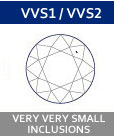 |
| VS-1/VS-2 |  |
| SI-1/SI-2 | 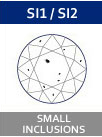 |
| SI-3 | 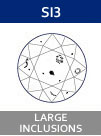 |
| I1-3 |  |
COLOUR : When we speak of Colour in a diamond, we actually mean the degree of colourlessness. While most diamonds are white, not all are truly colourless. Many are tinted yellow to brown or silver to grey.
In a white diamond, the presence of a tint is considered undesirable. This colour impurity is caused by lingering traces of nitrogen, boron, hydrogen or other elements. Commonly, diamonds are affected solely by nitrogen traces, which create pale yellowish or brownish tints. Only diamonds composed of 100% pure carbon without any impurities may be completely colourless.
Diamonds are graded on a Whiteness scale or absence of colour scale. Basically, the whiter or clearer the colour of a diamond the greater its value.
GRADING : The Gemological Institute of America (GIA) has devised a set of guidelines to grade diamond colour. The colour of graded diamonds is compared to that of control stones, which are preselected gems of a specific colour.
To be graded, diamonds must be loose stones, because once a diamond is set into metal the metal can affect its colour. Diamonds are placed table-down, pavilion-up and viewed with a 10X loupe under controlled lighting and precise viewing conditions. A lettering system from D to Z is used to identify the amount of colour present in each diamond, with D awarded only to rare, totally colourless diamonds. Many of these colour distinctions are so subtle that they are invisible to the untrained eye. But these slight differences make a very big difference in diamond quality and price.
Why does the GIA colour grading system start at D?
Before GIA developed the D-Z Colour Grading Scale, a variety of other systems were loosely applied. These included letters of the alphabet (A, B and C, with multiple A’s for the best stones), Arabic (0, 1, 2, 3) and Roman (I, II, III) numerals and descriptions such as "gem blue" or "blue white." The result of all these grading systems was inconsistency and inaccuracy. Because the creators of the GIA Colour Scale wanted to start fresh, without any association with earlier systems, they chose to start with the letter D—a letter grade normally not associated with top quality.
| color | |
|---|---|
| Size | Description |
| D | Absolutely colourless. The highest colour grade, which is extremely rare. |
| E | Colourless. Very negligible traces of colour can be noticed by an expert gemmologist. A rare diamond. |
| F | Colourless. Very negligible colour traces can be seen by an expert gemmologist, but still considered a "colourless" grade. A high-quality diamond. |
| G-H | Near-colourless. Colour noticeable when compared to diamonds of better grades, but these grades offer excellent value. |
| I-J-K | Colour slightly detectable. An excellent value. |
| L-M | Noticeable colour. |
| N-Z | Noticeable colour. |
The beauty of a diamond depends more on cut than any other factor. While all the other Cs are largely determined by Nature, cut is the one that can be determined by Man. For this reason, cut is perhaps the most important of the four Cs for us to understand.
Cut refers to the proportions, polish, and symmetry of a stone: these three factors are important in creating a diamond with the best possible light reflection. The angles and finish of any diamond are what determine its ability to handle light, and its brilliance.
When a diamond is well-cut, light enters through the table and travels to the pavilion, where it reflects from one side to the other before reflecting back out of the diamond through the table and to the observer's eye. This light is the brilliance, and it's this sparkling blaze that makes diamonds so captivating.
A poor cut, on the other hand, can cause light to seep out of the sides and bottom of the diamond, or it can limit the amount of light that enters a diamond. Poor cuts can therefore cause the diamond to appear dark, dull and lifeless, despite its colour and clarity grades. This is why cut is the most significant factor in the appearance of a diamond.
| SGS Cut Grades | Description |
|---|---|
| Ideal/ Excellent | Excellent light performance. Reflects almost all of the light that enters. Rare and extremely beautiful cuts. |
| Very Good | Very good light performance. Reflects almost all of the light that enters. Very Good diamond cuts are considered to be an outstanding value. |
| Good | Good light performance. Reflects most of the light that enters. Good diamond cuts are far less pricey than Very Good cuts. |
| Fair | Not as brilliant as a Good cuts or above, Fair diamond cuts are still considered good quality diamonds. |
| Poor | Poor cut diamonds are typically cut too shallow or too deep causing much of the light to leak out of the diamond's sides and base. |
Polish influences how well light is able to pass through a diamond. It is a very important attribute in determining a diamond's overall brilliance. When choosing a diamond, it is best to pick one that is laboratory certified with good, very good or excellent polish.
Diamonds with poor polish are significantly less brilliant because they have microscopic polish lines that blur the surface of the stone. They also reduce the amount of light that enters or exits the diamond. Be aware that many diamond have a poor polish because diamond cutters try and reduce costs by not spending sufficient time to properly polish a diamond.
| SGS Polish Grades | Description |
|---|---|
| EX | Excellent, Flawless at 10 power. |
| VG | Very Good, Extremely difficult to locate under 10 power. |
| G | Good, Very difficult to see under 10 power. |
| F | Fair, Noticeable under 10 power. |
| P | Poor, Easy to see under 10X / Visible to unaided eye. |
| VP | Very Poor, Relatively easy to see with the unaided eye. |
| EP | Extremely Poor, Obvious to see with unaided eye. |
Symmetry is an important element of diamond finish. Symmetry refers to the exactness of the shape and arrangement of facets. This includes naturals, misshapen facets and extra facets, off center culets and tables, wavy and out of round girdles, misalignment of crown and pavilion facets.
To the unaided eye, finish features usually have little effect on appearance; they are like pinpoint inclusions. The importance of symmetry is less important in diamonds that have lower clarity grades. Symmetry is more important in diamonds that have very high clarity grades.
When selecting your diamond, choose one of the following symmetry grades:
| SGS Symmetry Grades | Description |
|---|---|
| EX | Excellent, Flawless at 10 power. |
| VG | Very Good, Extremely difficult to locate under 10 power. |
| G | Good, Very diffucult to see under 10 power. |
| F | Fair, Noticable under 10 power. |
| P | Poor, Easy to see under 10X / Visible to unaided eye. |
| VP | Very Poor, Relatively easy to see with the unaided eye. |
| EP | Extremely Poor, Obvious to see with unaided eye. |
Luster, also termed as Briliance of a diamond indicates the brightness of the incident light, reflected back from within the diamond, as a result of the combined preciseness of the size and angles of its table, crown & pavilion facets.
At times, the rough diamond itself may inherently contain extremely miniscule but closely grouped bubble like structures or strands that may appear like a ‘cloud’ structure, which ultimately adversely affect light return of a diamond.
| SGS Luster Grades | Description |
|---|---|
| EX | Excellent Luster |
| VG | Very Good Luster |
| GD | Good Luster |
| FR | Fair Luster |
Beside, some diamonds may have a little whiteness or cloudiness present in them. These are known as milky luster diamonds. Such diamonds are further classified into sub categories depending on the extent of the milky effect in them, using the below terminologies:
| SGS Milky Grades | Description |
|---|---|
| ML-1 | Very Slightly Milky |
| ML-1.5 | Slightly Milky |
| ML-2 | Medium Milky |
| ML-2.5 | Medium Heavy Milky |
| ML-3 | Heavy Milky |
| ML-3.5 | Very Heavy Milky |
| ML-4 | Strong Milky |
Fluorescence in diamonds is graded on the following basis:
Emission of visible light by a diamond when it is exposed to ultraviolet radiation is termed as Fluorecence. A very high fluorescence reduces the briliance of a diamond.
Fluorescence color:
Depending on the nature and type of bonds that other elements form with carbon atoms of a diamond crystal, fluorescence can be of different colors.
Fluorescence colors like white, blue, yellow, orange and green are having direct impact on the overall color and hence the pricing of a diamond.| SGS Fluorescence Grades | Description |
|---|---|
| N | None Fluorescence |
| FNT | Faint Fluorescence |
| MED | Medium Fluorescence |
| STG | Strong Fluorescence |
| VST | Very Strong Fluorescence |
Black Inclusion (Natts) in diamonds are graded on the following basis:
Black Inclusions or Natts in general, are the inclusions that are found in the diamonds.
| SGS Black Inclusion | Description |
|---|---|
| B0 | No Black Inclusion |
| B-1 | Minor Black Inclusion |
| B-2 | Medium Black Inclusion |
| B-3 | Major Black Inclusion |
We generally specify two parts of the black inclusions:
Most of the wholesale diamond merchants grade diamonds on the basis of five types of inclusions such as, Pin Points (PP), Clouds (CLD), Crystals (CRL), Feathers (FR) & Spreaded (SPR), and then diamonds for sale are categorised accordingly.
Pin Point (PP): It is a very small crystal that looks like a tiny dot while using a 10 x loupe. Pin Points are generally white in color but occasionally they can be dark also.
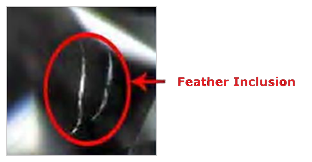
A feather is a general term for any break in the diamond.
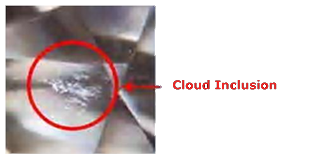
A cloud consists of many tightly grouped pin points. Some clouds look like a light haze, while others are dense and almost impossible to see through the naked eye.
Crystal (CRL): It is a mineral crystal contained in some diamonds. A crystal can be of almost any size, colored or colorless, and can appear alone or in groups.
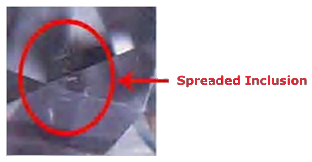
A spreaded inclusion appears when the feather inclusions are in greater number, spread across and not grouped together.
| SGS Other Inclusion | Description |
|---|---|
| N | None |
| PP-1 | Pin Point Minor Inclusion |
| PP-2 | Pin Point Medium Inclusion |
| CRL-1 | Crystal Minor Inclusion |
| CRL-2 | Crystal Medium Inclusion |
| SPR-1 | Spreaded Minor Inclusion |
| SPR-2 | Spreaded Medium Inclusion |
| SPR-3 | Spreaded Heavy Inclusion |
| FR-1 | Feather Minor Inclusion |
| FR-2 | Feather Medium Inclusion |
| FR-3 | Feather Heavy Inclusion |
| CLD-1 | Cloud Minor Inclusion |
| CLD-2 | Cloud Medium Inclusion |
| CLD-3 | Cloud Heavy Inclusion |
We generally specify two parts of other inclusions:
Open Inclusions are the inclusions that are on the surface of the diamonds. Wholesale dimaond merchants grade diamonds with open inclusions on the basis of five types that are mentioned below:
| SGS Open Inclusion | Description |
|---|---|
| N | None |
| HL | Hair Line Open Inclusion |
| SM | Small Open Inclusion |
| MD | Medium Open Inclusion |
| HV | Heavy Open Inclusion |
We generally specify two parts of other inclusions:
Extra facet is that extra facet placed on the normal facets of the diamonds without considering the symmetry of the diamond. These facets are additional to those required for making the diamond a brilliant cut diamond.
| SGS Extra Facets Grade | Description |
|---|---|
| N | None |
| P_SM | Pavilion Small |
| P_MD | Pavilion Medium |
| P_MJ | Pavilion Major |
| P_HV | Pavilion Heavy |
| C_SM | Crown Small |
| C_MD | Crown Medium |
Below are extra specifications for the internal graining in the comment column:
Only after complete assurance of above mentioned gradings, we make diamonds for sale available to our valued clients.
Sanghvi & Sons specializes in 0.30 cts to 10.00 cts polish loose wholesale diamonds with GIA & IGI Certification, from IF to I2 clarity, D-N & all fancy colors, in numerous shapes. Each of our diamonds(loose diamonds for sale) passes through a rigorous quality control unit where our qualified craftsmen assess it finely. Our skilled artisans work persistently to deliver flawless quality diamonds that comply with the stringent specifications in diverse shapes, various colors and clarities.

The round brilliant cut diamond is by far the most popular and most researched diamond shape available today. For almost 100 years, diamond cutters have been using advanced theories of light behavior and precise mathematical calculations to optimize the fire and brilliance in a round diamond. We make these diamonds available as loose wholesale diamonds.

What makes this shape different is its pavilion, which is cut with rectangular facets to create a unique optical appearance. Due to its larger, open table, this shape highlights the clarity of a diamond. Availing these loose diamonds for sale is a challenge in itself. We not only took challege, but passed the test as a dimaond exporter with flying colours.

The shape of a marquise diamond can maximize carat weight, giving you a much larger-looking diamond. This brilliant-cut diamond looks beautiful set with round or pear-shaped side stones, and the length of the marquise makes fingers appear long and slender. We take pleasure in availing these loose diamonds for sale to our valued clients.

An oval diamond has beautiful brilliance thats similar to a round diamond. Oval diamonds are also very popular as their length can accentuate long, slender fingers. To see loose wholesale diamonds in oval shape is a treat to eyes and availing these loose diamonds for sale is our delight.

This brilliant-cut diamond is also called a teardrop for its single point and rounded end. The unique look of the pear shape helps make it a popular choice for a variety of diamond jewelry and favourite in loose wholesale diamonds market. If you choose an elongated pear shape, the length of the diamond creates a subtle slimming effect on the fingers.

This is our most popular non-round diamond. Its beautiful brilliance and unique cut makes it a favorite for engagement rings. The princess has pointed corners and is traditionally square in shape. We take great pleasure in availing thse loose diamonds for sale.

The heart is the ultimate symbol of love. The unique look of the heart-shaped diamond helps make it a distinctive choice for a variety of diamond jewelry. Loose wholesale diamonds in heart shape are priceless.

A trilliant cut is a type of gemstone cut, which is triangular, as the name suggests. It is sometimes called trillion, or trillian. The cut comes in two different variations, with curved and uncurved sides. In addition to side variations, the top surface of the cut also varies. Our loose wholesale diamonds collection has a large variety of such precious trillion diamonds.

This unique shape has been popular for more than a century. Cushion-cut diamonds (also known as "pillow-cut" diamonds) have rounded corners and larger facets to increase their brilliance. These larger facets highlight the diamond's clarity. If you question us about the availability of these loose diamonds for sale, we will nod with a wide smile.

Rose cut diamonds were introduced as early as the 1500's and were popular until the early 1900's. The shape of a rose cut diamond resembles the petals of a rose bud. The bottom is flat. The crown is domed shaped and the facets meet in a point in the center. The number of facets varies from 3,6,12,18,to 24 facets. Loose wholesale diamonds of rose cut are in great demand and we try to meet these demand with utmost professionalism.

Radiant cut diamond is considered the father of branded fancy cut diamonds with a birth over 20 years ago. Originally protected by patent, the design is now public domain. The radiant cut diamond is the first rectangular cut to have a complete brilliant facet pattern applied to both the crown and pavilion and as such presents a much more dazzling and brilliant diamond than the simple emerald cut. When you ask for radiant loose diamonds for sale, we know how precious they are for you and therefore make every effort to meet your requirement exactly the way it is.

Providing top-notch polished diamonds and round diamonds for the past 40 years with the assurance of a certified diamond. We provide a place to buy Diamond online to satisfy the demand which helps you to buy real diamond online conveniently and securely.
